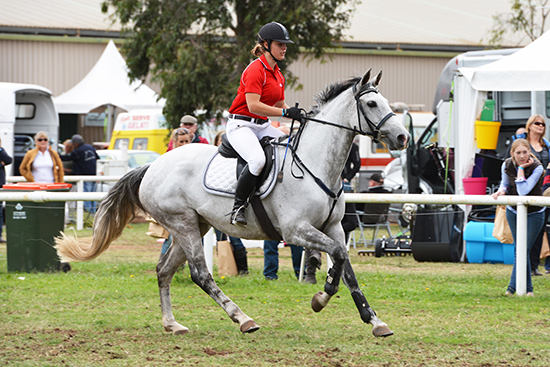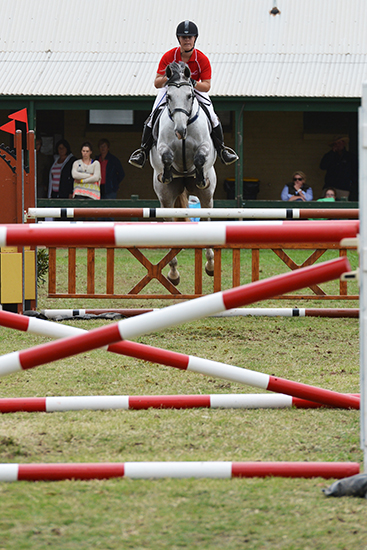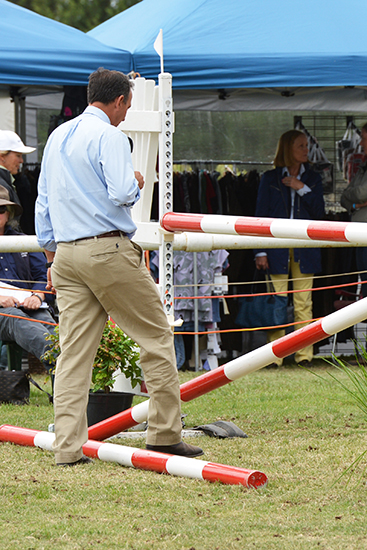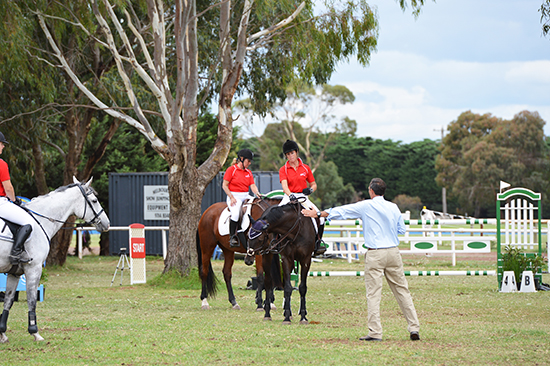 Story by Chris Hector & Photos by Roz Neave
Story by Chris Hector & Photos by Roz Neave
Okay, I know I have said it more than once, but it is worth saying again and again, Greg Best is a genius. If I keep saying it often enough, maybe one of the jumping experts in the EA federal office might even hear, better, they might even realise that one of the world’s greatest jumping coaches is just across ‘the ditch’ in New Zealand…
At DJWTS 2013, Greg conducted a magical master class. For a lot of the time, he concentrated on using a gymnastic line he invented to teach the horses and riders to get the revs up coming out of the corner on the approach to the jump, so they could gradually power down as they actually came to the jumps.
“This line is really good for developing the horse’s front end. It also teaches the riders to come out of a corner and really commit. It also teaches horses to respect and come back to the rider.”
“It is a line that I have probably seen nearly 20,000 horses jump, and I have seen it jumped, maybe a quarter of a million times. It is a line that I use a lot…”
“It is actually one of those lines that Pony Hunters, Jumpers, Eventers, they can all do the line. The ponies can go down and do the five strides to one stride very safely. I can have amateur riders do it, and because it is only vertical, vertical at a low height, it is a very safe line. Even if they happen to bounce out, or get into trouble and get four and a half instead of five, or four and a half instead of four, the double vertical combination is very very forgiving.”
“It is oxer, vertical, vertical; 57 feet to 21 feet. 57 feet being about three feet short of a normal four strides, and 21 being about three feet short of a normal one stride – between two verticals, even 24 feet is quite short. It is one of those lines where people might not think it through, they think, oh if it is three feet short of a normal four stride distance, then three feet short of a normal one stride distance then they are both equally short. Wrong. On a per stride basis, the one stride is three feet short of a normal one stride, while on a per stride basis for the four strides, it is actually less that one foot short of the normal length per stride. So the four is on a per stride basis, much longer than the one stride distance.”
“This exercise is going to ask for adjustability, for lengthening and shortening. Not long and slow, not lengthening and flattening, lots of trainers use longer and faster interchangeably – they are very different qualities. Use more leg and body to ask the horse to go bigger, use your voice to slow them down.”
“When you go down the line you are reducing about six inches per stride.
On the first stride after landing you might take a few ounces with your hands, but just before the next jump, you might need to take with lots more weight. Some days we can train with a feather touch, some days, it’s a sledge hammer.”
“How much (forward) should you start with? As much as you can control, you don’t want to accelerate over the oxer, you want to accelerate out of the turn. That is one of the hardest commitments to make in jumping, to commit to lengthen before you can see a stride. If you are going to make the commitment to the right length of stride, six strides out, you have to do it before you see a distance. I’d rather you missed your distance on the right length of stride, than get the distance, on the wrong stride. Horses can help you find the distance, they can’t help you find the length of stride.”
“This is a line I practise a lot to encourage the horses to progressively decrease down a line. I ask the riders to start with more than average, and finish with less than average. Most lines, riders think of riding into the line with a length of stride that is required on average throughout the line, but not all lines are set that way. Some times you have a line that is say, a shorter four stride, to a bit of a longer one or two. To me it makes sense that you should jump into that line with a shorter stride and allow the horse’s stride to gradually progress. Naturally horses do that well, naturally riders come out of a turn with a shorter stride than what’s required on average, it lets them procrastinate a little bit longer. Every rider feels more confident if they hold until they see a distance, rather than riding forward to see a distance. What my exercise does, is that it tests both the rider’s ability to start with more, and finish with less, and we then challenge the horse to also finish with less. As much as the riders are inclined to start with less, the horses are also inclined to finish with more.”
When you say ‘less’ – do you really mean just increasing the impulsion and the collection of the stride or do you really mean, less?
“This is something that is really unique about this line, the end of the line really requires no impulsion, all the horses have to do is jump straight up in the air. They don’t need a lot of power to just go straight up in the air. It is actually a line that challenges the rider to be able to control the length of stride for sure but also control the energy in the stride too. The energetic, quick horses, really struggle with this line. The slow moving lazy horses, eat it for lunch. It is a line where the riders are challenged to create this lively energetic longer stride to the oxer, then this progressively decreasing length of stride, and controlling the energy in that stride as well. I am a big fan with this line, of getting the riders to use their voice, I think the voice isn’t there to control the length of stride, the voice is there to control the animation and the energy within whatever stride length it is that the rider’s hand is creating.
The hand controls the length of stride, the voice is there to try and encourage the appropriate energy in the stride.”
“My feeling is that if you are looking for that short, sharp, quick, energetic stride, it is hand, leg and a bit of cluck, trying to keep that quick, quick stride. With my line, the riders are going down there, lots of hand, a bit of leg, just to make sure the horses don’t fall behind them, but then saying, ‘whoa’ and trying to get the horse to be very slow at the end of the line.”
“This line that I set up, it might be the 7-8-9 jump on the course, where the horses are naturally getting geared up and a little bit more lively and aggressive, so not only do the riders have to control the length of stride, but at the end of the course, they somehow have to try and manufacture a horse that is slower, and more relaxed.”
When I configure the jumps – oxer, vertical, vertical – I try to make the oxer a big, scopey, rangey oxer, where the riders really have to have a positive assertive ride to make that work. If the oxer was a vertical, or if the oxer was not a significant jump, I actually think my line would be better ridden in five to one, even though, four walks three feet short of the normal four, it actually rides very easily, a five to the one, if the first oxer is not a big meaty oxer. But when it is a big meaty oxer, the way I try to set it up, it takes away the ability for the rider to ride to the first part of the line on a short, compact stride.”

“As the jumps get bigger, it gets exponentially more difficult. It is not something people can readily appreciate, the difficulty of this line, until they see it or ride it, when it is bigger. That line at a 1.60m is death defying! Absolutely death defying. I have only ridden it, or seen it ridden, at 1.50m level, maybe three or four times – three or four horses have done it out of a lot of horses. It is a very challenging line at 1.40m. Most Grand Prix, even World Cup, horses, can do the line at 1.40m, 1.45m, much bigger than that, it is almost too hard. The bigger jump does in theory require more energy, and then the rider has to somehow control that energy and make it go up rather than out, which at the end of a line is a very hard thing to do.”
So how did Mr Best’s Aussie riders cope with the challenge?
Well first, he made it a bit tougher…
“I’m a nut about a lot of things, but straightness is right up there. I don’t even want to see your head turn over the jump. Riders always ask – was I straight?”
“There are millions of degrees of crookedness, butt turners, shoulder turners – but there is only one straight. Horses must learn that by default, they are straight. Your goal is not only to be straight on the horse, but to produce straightness in the horse. I’d like to show you an exercise to detect slight variations of weight in the stirrups. Take the stirrups off and buckle the leathers together. Everyone who rides, and that includes dressage riders, should do this exercise. So many riders look straight and correct, and they are not. Most riders twist to the inside, and put extra weight on the outside – and you’ll see when you do this exercise, that the outside stirrup always gets longer. With this exercise, one rider in three will fall off, some will fall on the canter depart. Go home and do it, trust me you will be amazed – BOOM – this is a really enlightening exercise.”
That was difficult enough, but then Greg had Kristy Haworth ride the line, still with her stirrups loose across the top of the saddle and she did it perfectly:
“Remember, Kristy is still riding with the funky stirrups, the slippy stirrups, and she makes it look easy. See there, Kristy was straight until coming out of the combination, then she had a little twist. This exercise is great because I don’t have to tell you what you’ve done.”
“It’s a funny line. It really punishes quickness, the horse that wants to get to the jump and go quick and flat. It doesn’t punish a big slow moving horse. This exercise teaches the horse to compress the stride – step by step we connect the dots. It is a great exercise teaching the horse to regulate the stride.”
This article first appeared in the June 2013 issue of THM.





